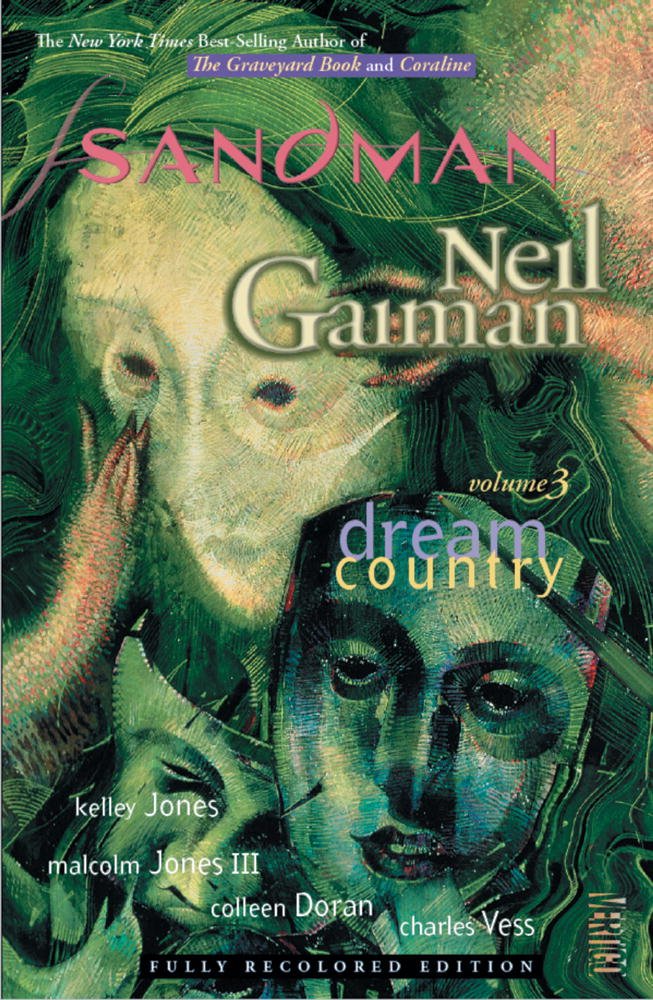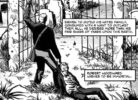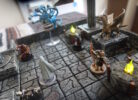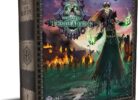Eight years ago, Stephen Segal, then creative director at the legendary Weird Tales magazine, asked if he could use some modest writings I had been doing on Neil Gaiman’s Sandman for a 20th anniversary retrospective he was putting together. Naturally, I said yes. Sadly, the series was lost in a website revamp. Not wanting it to disappear into the ether, I’m now presenting it on my site in 11 parts (alas, without the benefit of Stephen’s editing; these are pre-publication versions). Hope you enjoy.
Recurring Dream: An Anniversary Re-reading of Neil Gaiman’s Sandman
Part 4 of 11, Dream Country
Originally published on the Weird Tales website, January 2009
 You wouldn’t think a collection of one-off stories would be where Neil Gaiman finds his voice, but that is exactly the case. Dream Country, the third collection of his acclaimed Sandman, is made up of four one-shot stories. Each is different from the last. And each one is excellent.
You wouldn’t think a collection of one-off stories would be where Neil Gaiman finds his voice, but that is exactly the case. Dream Country, the third collection of his acclaimed Sandman, is made up of four one-shot stories. Each is different from the last. And each one is excellent.
The real treat here, however, is that this collection pushed Sandman out from its light horror/dark fantasy origins and finally showed the world what Sandman was capable of being. Which is to say, Sandman can be almost anything.
I think that was Gaiman’s idea. The very concept of who and what Dream is was in part to allow him to do a wide variety of stories; whatever suited his fancy at any given time, he could go there. We’re not limited to tales about serial killers and demons. Time nor place nor tone is an obstacle. Sandman can be ANYTHING, and at times it is.
Part of what makes the series special, this.
The first story here is “Calliope,” a tale in which the muse of the same name is kept captive for a greedy, selfish writer. This is probably the weakest of the bunch. That’s no insult, though, as Gaiman manages to blend mythology and horrid people and a satisfying ending. Still, it’s rather mundane, all things considered, with nothing that screams “SANDMAN!” A “careful what you wish for, you just might get it” tale and little more. This could have been a John Constantine story or a Swamp Thing story and you’d not bat an eye. Oh, there is a dream sequence, sure, but it’s not essential.
Of course, as with all things Sandman seeds are planted here that will bear fruit later. Dream has a son? How interesting …
It’s followed by the wonderful “A Dream of a Thousand Cats,” in which cats ponder ruling the world (and, as in many stories, we see yet another aspect of Morpheus). The art is perfect for the story, a sort of twisted fairy tale come to life, and the writing … well hell, the head kitty’s monologue inspired me to dream of cats ruling the world. Quite poetic. I liked this one because it underlines an important idea: That dreams are powerful, world-changing things.
This is a theme that runs throughout the series. Dreams – the stuff of ideas and inspiration, of beauty and love and fear and horror – can change who we are and what we become, and in turn we can change the world around us for good or ill. Ideas are powerful things. Even more powerful is man’s willingness to be inspired by them. The world is what we make of it. It is a reflection of who we are.
This is, I think, one of the foundations upon which Sandman is built.
Third out of the gate is the award-winning “A Midsummer Night’s Dream,” which picks up seeds Gaiman dropped in a one-shot story featured last volume. (Again: NOTHING is “standalone” in the world of Sandman.) How he manages to hold this one together, I do not know, but he does. The story jumps from scene to scene like a frog on a hot plate. First we’re seeing a brief exchange between two characters, in the next panel it’s something else, and in the third it’s something else yet again. The dialogue jumps back and forth between excerpts from Shakespeare and the story. The whole thing just flips and flops and is all over the map. There is little to no sense of continuity here at all.
Yet it works. Somehow, Gaiman’s approach makes this tale almost dreamlike, like a fevered vision seen at dusk, when the shadows begin to come alive and the day withers in the face of the night. Quite appropriate, given the subject matter.
I don’t think this is the finest of the Sandman one-shots – that one comes later – but it is fine. Overpraised perhaps, but still quite good.
Finally is “Façade,” in which Gaiman scoops up an obscure old Legion character (Element Girl, though she’s never named) and … well, I won’t spoil what happens with her, but it’s a tragic tale with a happy ending, an examination of isolation and feeling alone and wanting so badly to end it all but not being able to do it. Quite an affecting work with bleak and moving artwork by Colleen Doran. There are some truly haunting moments, such as an awkward dinner scene, and Gaiman does an amazing job of getting across this woman’s pain. Though an utterly inhuman character, she’s one of the most human people you’ll ever read. Fantastic stuff.
So, four stories, four wildly different approaches, four entirely different spins on who and what Sandman could be. Nice vignettes that serve to show us “business as usual” Dream before we launch into the world-shaking events of Season of Mists.
Gaiman’s chess pieces are now in place. From this point forward the game truly begins.








I’m really enjoying this series and will follow it til the end!
I don’t think Element Girl is connected to Legion, though (despite her name matching the pattern that team has):
https://en.wikipedia.org/wiki/Element_Girl
Thanks for the clarification, Mr. Whiteley Sir! I’ll be the first to admit that my DC knowledge is not up to snuff, so no surprise if this is an error on my part. And thanks for reading along!
Pingback: Looking back at Neil Gaiman’s Sandman – part 9 of 11, World’s End – ERIC SAN JUAN